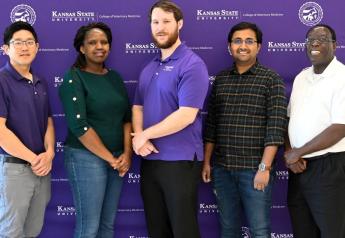The Truth About Influenza and Pigs

Mistruths and incorrect information are making headlines about a possible “new pandemic virus” in pigs. A team of Chinese researchers recently reported on their findings for influenza in pigs from 2011 to 2018. The article, published in April, is now circulating in news headlines.
“Any discussion of illness during a global pandemic naturally raises concerns, but it’s important to note this H1N1 is not a new strain of influenza,” says Dave Pyburn, DVM, chief veterinarian for the National Pork Board. “It has been in China’s hog population since before 2016 and has been a predominant strain in Chinese pigs since that time. The science in this paper is sound, but the conclusions and resulting news stories lack important scientific context. We need to make sure that we stick to the scientific truth and not over-sensationalize the findings.”
The truth? Yes, it is a swine virus. Yes, it has the potential to transmit to humans – just like all influenzas can. But experts say there’s no scientific reason to believe that this virus strain in China is any riskier than any other influenza virus. Here are five reasons why Pyburn says there is no reason to panic:
1. This is not new.
The surveillance of influenza in swine took place from 2011 to 2018, this is not something that was discovered in the last few months. Pyburn says the journal article explains that this “G4” reassortment of this H1N1 influenza has been the predominant strain in China’s swine population since 2016.
“This has been in China for years,” he explains. “They've known about it for some time, which also means the World Health Organization (WHO) and the Centers for Disease Control and Prevention (CDC) have also known about this for a while, and that's important.”
2. Humans can build antibody against this strain.
According to the journal article, researchers sampled 338 workers from multiple farms in China. Of those 338 workers, 10% of the workers (35 people) had antibody to this particular strain of H1N1 influenza.
“That’s important because it tells you then that we are able to build antibody against this strain,” he says. “The other important piece that I take from this paper is that they do not speak to any human illness attributed in that slaughter plant to this strain. That’s not to say there wouldn't be, but it must not have been profound if there's nothing here to report on as well. So that's good news.”
With no evidence of human-to-human transmission and a 10% prevalence in humans, it would seem to be indicative that human-to-human transmission was not occurring, Pyburn adds.
3. WHO monitors the most likely influenza viruses to include in annual vaccine.
Keeping in mind the WHO and CDC are already aware of this strain of influenza, each year WHO gathers globally and looks at what strains of influenza need to be included in the human vaccine. So far, this strain has not been put into the human vaccine.
“It's likely they deemed that it's not as important or as likely to be spread, so it’s not one of the top three that they would put into a vaccine for people at this time. One of the strains that is in the vaccine we get in the U.S. is the strain from the 2009 H1N1 influenza pandemic,” Pyburn says.
The WHO has a candidate human vaccine for a very similar strain of influenza, which is genetically very close to the strain in the study, he explains. That work predates the publication of this study.
4. USDA monitors influenza in the U.S. swine herd.
USDA has been running an influenza surveillance program in pigs for more than 10 years, Pyburn says. If this strain of influenza were in the U.S. swine herd, USDA researchers would know about it. Since 2009, USDA has partnered with CDC in a joint influenza surveillance program in pigs and people.
“By collaborating and sharing scientific information on influenza strains, significant efforts have been made to protect both human and swine health. This strain of influenza has not been found in either surveillance mechanism,” he says.
5. The U.S. pork industry practices high biosecurity to keep disease out.
Producers have biosecurity precautions in place to protect pigs from that directional flow of flu that could happen from humans into pigs as well from pigs to people. From wearing a face mask and eye coverings in the barn to encouraging employees in contact with pigs to get the annual flu vaccine.
“Pork producers shouldn't get so focused in on this particular flu, but instead remember that there are multiple flus out there that can infect their pigs,” Pyburn says. He encourages producers to take a close look at their biosecurity plan and what's coming onto the farm, in addition to how they're protecting their workers on their farm.
“Influenza has become a potential virus within our barns on a year-round basis, whereas before it was more of a seasonal type of infection in our pigs,” Pyburn says. “Take a look at vaccine protocols for both your pigs and your workers.”
Influenza is a respiratory disease and is passed from direct contact – it is not a concern to the food supply.
“This is not a food safety issue,” Pyburn emphasizes. “It's more about humans and pigs in contact with each other. And that's where we need to take the precautions.”
He says the best part of living in the U.S. is the safety of the food supply.
“We have the absolute safest food supply in the world,” he says. “And that goes back to USDA and the inspection process that our pigs and our meat go through before it ever gets to the grocery store or restaurant table. Sick pigs are not in the in the slaughter chain at all, only wholesome, healthy meat makes it to our tables.”
More from Farm Journal's PORK:
6 Ways to Protect Pigs and People at the Fair
Protect Your Pig Farm: Get Your Flu Shot
Piecing the Puzzle Together: Diagnostic Monitoring and Flu Prevention
Influenza D: Is it a Risk to Humans?
Influenza Season Requires Precaution in Handling Pigs







